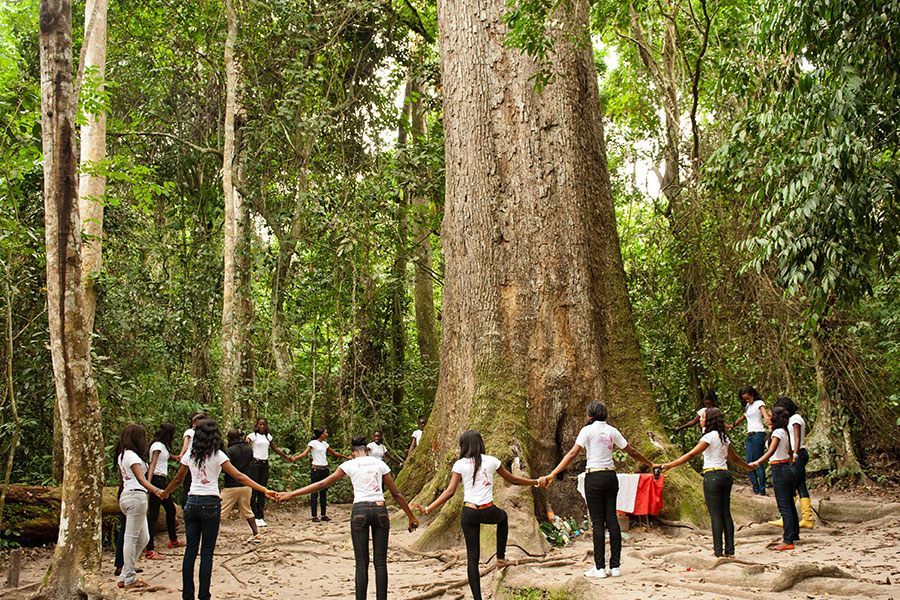There once stood a tree. It had stood for longer than the oldest person had lived in that area, and almost longer than America had been a country. It reached higher than our necks allow us to see – a skyscraper of the Amazon, some may say. It’s home to our friends with wings, plants and crawling critters, playing children and the air we breathe. Yet for outsiders it’s simply a tree. It may just be one tree, but for 25 communities living along a river in the Ecuadorian Amazon, there are only three other living trees like this in existence.
In spite of this, in the eyes of some outsiders, this tree is replaceable by the plentiful other trees around it. Foreigners might ask – within a territory covered in greens of all shades and barks of all textures – “what’s the value of just one more tree?” Well, through a local viewpoint, no other oxygen-omitting being would begin to suffice.
An endangered species, they protested. Spiritual symbolism, they claimed. Historical significance, they explained. In a place in which nature and culture are commonly intertwined it felt as if the possible destruction of nature was equally a possible destruction of their society. The intruders, as a few Amazonian’s framed it, began to propose a scheme of deforestation. They cleverly assembled a proposition stuffed with linear logic of growth and capitalistic gain – gain for themselves of course, not the locals. $20 for a 200-year-old tree that could still grow for a further one hundred years.
Perhaps they fell asleep during that part of their environmental science class that explained that, for a tree of that size, at least 200 years more years should pass. They do say time is money, but the locals struggled to accept that $20 equates to 200 years of time. I think they were even further puzzled when the constructors attempted to rationalise the offer by saying it would only take four hours of their time. Four hours pass and the construction site would be a hidden site.
Or on the other hand, four hours pass and the construction site would be a graveyard site to the natural, spiritual, social and cultural elements that stemmed from that tree. Fortunately, a few activists were not willing to put up a tombstone. It takes one thought, one person, one group, one action to change the course of what some believe may be fate. In this case it was one proposal. An outside group stepped into the negotiations and raised the offer by $80.
Rather than $20 to cut the tree down, how about $100 to leave the tree untouched? The team of constructors were not swayed by the three-digit offer. At this point, while some lost hope, others transformed their lost hope into confidence – for saving the tree. Workers from a local social enterprise joined the movement and they made a commitment to each other to protect this historical, spiritual, playful being of a tree.
As I mentioned before, to change the course of the future begins with us.
As I mentioned before, to change the course of the future begins with us. From an idea to initiative to execution of our vision, we are able to achieve our mission. Even when the first attempt fails that does not mean that the second or third shot should also disappoint. The local’s story follows this pathway. Although the foreigners thought they were rather clever, the locals accessed some indigenous genius. They expressed that the tree the outsiders were hoping to kill resided within indigenous territory. These foreigners did not just stumble upon land with the right to claim or destroy any element of it.
There was no equivalent phenomenon to Columbus discovering America “by accident.” For this reason, the foreigners consequently had to play by indigenous rules. It only took some creative, innovative thinking to completely switch the situation around. Now, those wearing the power shoes were the locals, with land, rather than the foreigners with money. If you want any more nights with your families, the locals warned, you’d better hustle out of our terrain.
Of course this was an intimidation tactic rather than one they would straightforwardly follow. Nonetheless, they provide the proof that with dedication to a particular belief, no obstacle stands in the way as a barrier. Although less politically significant or economically established, their drive to lead and achieve was more powerful than imagined. After clearly outlining the importance of the tree and exposing the ignorance of the outsiders, a deal was closed.
With a voice willing to speak up for what they believed in, they not only saved the tree, but also initiated a continual benefit from the tree; each month $100 is dispersed throughout the community which helps to support the families of the village. In what seemed an unfortunate event, fortune was actually found.
Much of our life and what we aspire to achieve is dependent on how we choose to go about living; whether we accept circumstances or take circumstances into our own context.
Much of our life, and what we aspire to achieve, is dependent on how we choose to go about living; whether we accept circumstances or take circumstances into our own context. As these Amazonian’s taught me, there is power in “one.” In the same way a match has the ability to light a candlelight, a bonfire, a devastating house fire or forest fire, our beliefs and goals can also leave an impact of any size. After all, an obstacle is only an obstacle if we perceive it to be.
So, when presented with what seems bad, reconsider how this “unfortunate” event may actually result in fortune.




































